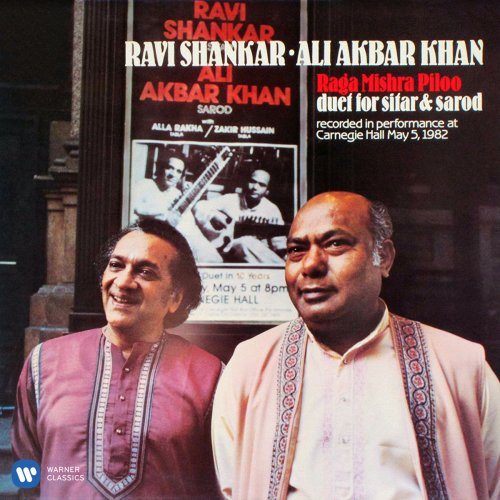
Ravi Shankar - Raga Mishra Piloo (Live at Carnegie Hall, 1982) (1983/2020)
BAND/ARTIST: Ravi Shankar
- Title: Raga Mishra Piloo (Live at Carnegie Hall, 1982)
- Year Of Release: 1983/2020
- Label: Warner Classics
- Genre: Classical, World
- Quality: FLAC (tracks)
- Total Time: 56:09 min
- Total Size: 259 MB
- WebSite: Album Preview
Tracklist:
01. Raga Mishra Piloo (Live at Carnegie Hall, 1982)
01. Raga Mishra Piloo (Live at Carnegie Hall, 1982)
Born on April 7, 1920, in Varanasi into an orthodox, well-off Brahmin family, Rabindra Shankar Chowdery's father, ShyÆm Shankar, was employed as a diwan (minister) by the Maharajah of Jhalawar. By the age of 13, Ravi Shankar was going along on every tour of his brother Uday Shankar's Compaigne de Danse et Musique Hindou (Company of Hindu Dance and Music). At the All-Bengali Music Conference in December 1934, he met the multi-instrumentalist Allauddin Khan. Precisely when Allauddin Khan was born is uncertain. People hazard dates in the 1860s around 1862, but in later years he himself gave his age haphazardly. He would transform many musicians' lives, but he had an incalculable effect on Ali Akbar (his son), Annapurna Devi (his daughter), and Ravi Shankar himself. Allauddin Khan joined Uday's troupe as its principal soloist around 1935-1936. In 1938, Ravi Shankar gave up a potential career as a dancer and went to study with Allauddin Khan in Maihar. In 1939, he began giving public recitals and came out of training at the end of 1944. Until 1948, he based himself in Bombay and gave programs all over India. He toured and wrote for films and ballet. Around this time he began his recording career with a small session for HMV (India). Work for All India Radio followed; as music director from February 1949 to January 1956 in New Delhi. Concurrently, his international star was on the rise. In 1954, he performed in the Soviet Union. In 1956, he played his debut solo concerts in Western Europe and the U.S. Within a decade he would be the most famous Indian musician on the planet. Within two decades he became probably the most famous Indian alive. His English-language autobiography, My Music, My Life (1969), is still one of the best general introductions to Hindustani music. It would be hard to over-estimate his influence in late 20th century Western music. His disciples have included George Harrison and Philip Glass. Shankar was not one-dimensional. Apart from pursuing a career as a classical performer, he also experimented outside this field. For this reason he has attracted criticism from purists. Some of this, especially during the Beatles era, undoubtedly had an element of jealousy to it; and some was certainly warranted, because Shankar did take many chances. In fact, that was one of the things that kept his music exciting. To use a cricketing image -- baseball would be wholly inappropriate -- Shankar's batting average remained high throughout a long and illustrious career. In later life, he spent a great deal of time in the US at his home in California, and continued to give spellbinding live performances well into the new century. However, his final concert took place in Bangalore, south-west India in February 2012, where he shared the stage with his daughter, Anoushka. Following a long period of ill health, Shankar sadly passed away at a San Diego hospital on December 11th 2012, aged 92.
Year 2020 | Classical | Instrumental | World | FLAC / APE
As a ISRA.CLOUD's PREMIUM member you will have the following benefits:
- Unlimited high speed downloads
- Download directly without waiting time
- Unlimited parallel downloads
- Support for download accelerators
- No advertising
- Resume broken downloads


